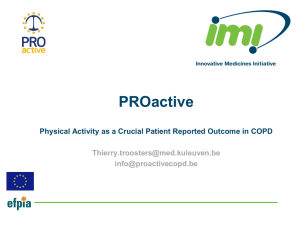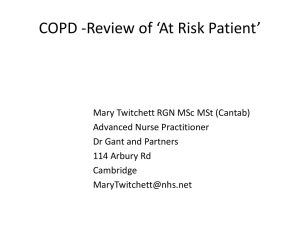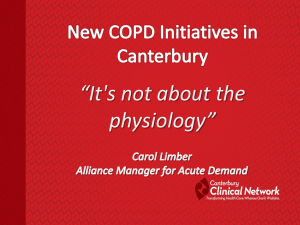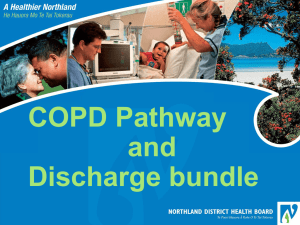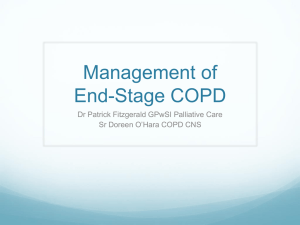COPD - vanel
advertisement
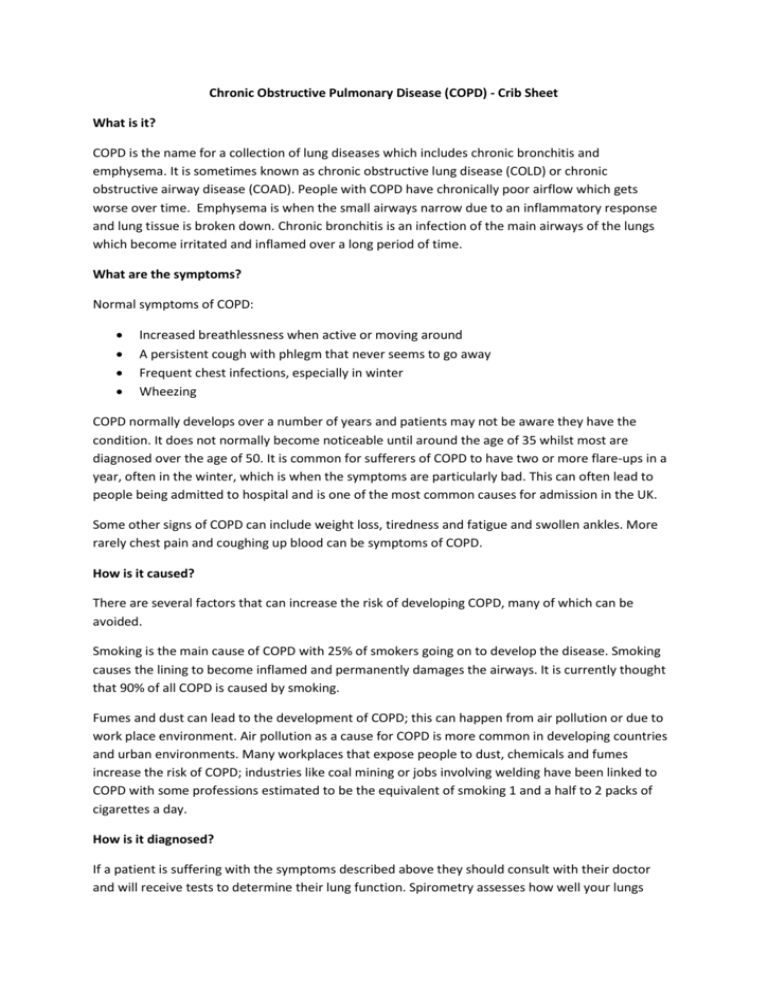
Chronic Obstructive Pulmonary Disease (COPD) - Crib Sheet What is it? COPD is the name for a collection of lung diseases which includes chronic bronchitis and emphysema. It is sometimes known as chronic obstructive lung disease (COLD) or chronic obstructive airway disease (COAD). People with COPD have chronically poor airflow which gets worse over time. Emphysema is when the small airways narrow due to an inflammatory response and lung tissue is broken down. Chronic bronchitis is an infection of the main airways of the lungs which become irritated and inflamed over a long period of time. What are the symptoms? Normal symptoms of COPD: Increased breathlessness when active or moving around A persistent cough with phlegm that never seems to go away Frequent chest infections, especially in winter Wheezing COPD normally develops over a number of years and patients may not be aware they have the condition. It does not normally become noticeable until around the age of 35 whilst most are diagnosed over the age of 50. It is common for sufferers of COPD to have two or more flare-ups in a year, often in the winter, which is when the symptoms are particularly bad. This can often lead to people being admitted to hospital and is one of the most common causes for admission in the UK. Some other signs of COPD can include weight loss, tiredness and fatigue and swollen ankles. More rarely chest pain and coughing up blood can be symptoms of COPD. How is it caused? There are several factors that can increase the risk of developing COPD, many of which can be avoided. Smoking is the main cause of COPD with 25% of smokers going on to develop the disease. Smoking causes the lining to become inflamed and permanently damages the airways. It is currently thought that 90% of all COPD is caused by smoking. Fumes and dust can lead to the development of COPD; this can happen from air pollution or due to work place environment. Air pollution as a cause for COPD is more common in developing countries and urban environments. Many workplaces that expose people to dust, chemicals and fumes increase the risk of COPD; industries like coal mining or jobs involving welding have been linked to COPD with some professions estimated to be the equivalent of smoking 1 and a half to 2 packs of cigarettes a day. How is it diagnosed? If a patient is suffering with the symptoms described above they should consult with their doctor and will receive tests to determine their lung function. Spirometry assesses how well your lungs work by breathing into a spirometer. This takes two measures; the volume breathed out in one second and the total amount breathed out which will be compared to normal measurements. Other tests may be required to rule out other conditions or check severity such as a chest x-ray, blood tests, phlegm test or peak flow tests as a few examples. Those with the risk factors highlighted above should consider getting tested for COPD especially if they are over the age of 35 as early treatment can slow down the deterioration of the lungs. How is it treated? Currently there is no cure for COPD but treatment can slow progression of the disease and reduce the severity of the symptoms. One of the best ways to reduce progression of the disease is to avoid risk factors associated with the disease such as stopping smoking. To help manage the condition a doctor may prescribe inhalers which can deliver a dose of bronchodilator which relax and open up the airways. Steroid inhalers can also be offered which reduce inflammation in the airways. Medicines may be given which could include antibiotics, steroids, mucolytic tablets (thin mucus and phlegm) or theophylline tablets (relax and open up the airways). Other types of treatment could involve surgery (such as lung transplantation), oxygen therapy, noninvasive ventilation (a portable machine to help breathing) or rehabilitations programmes (provide an exercise regime and education by a multidisciplinary team which can include physiotherapists and respiratory nurse specialists). What support can help people feel and get better? Good self-care can allow those suffering with COPD to live longer, in less pain and with reduced anxiety. With support to help people take responsibility of their own health and wellbeing they can have a better quality of life. Smoking is the predominant cause of COPD and so encouraging people to reduce and eventually stop smoking should be a priority. Patients who exercise and keep active regularly have improved breathing, less severe symptoms and better quality of life overall. Maintaining a healthy weight can reduce the impact of COPD; being overweight can make it more difficult to exercise and also make breathlessness worse. COPD is a chronic illness which is known to cause tiredness and depression, some people may also no longer be able to work which can add to the burden financially as well as take away purpose. Support on financial benefits available and how to access them could help reduce the burden for people with COPD and aid mental wellbeing. One example of a community service to help people with COPD is a singing group specifically for people with COPD. The group helps improve physical health exercises that aid breathing as well as improve mental wellbeing by offering a group of similar people that can support each other and address social needs.



